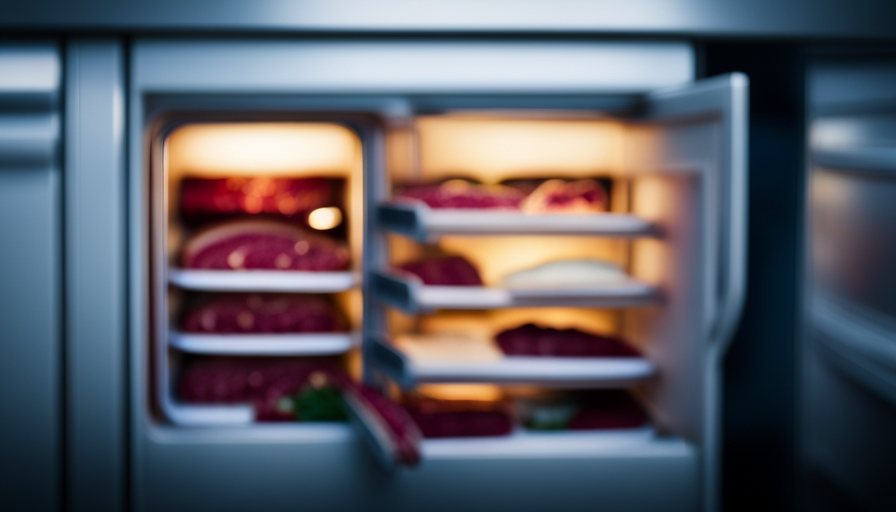Similar to how a conductor directs an orchestra, proper food storage is crucial in preventing a variety of foodborne illnesses. The placement of raw meat in relation to other foods is essential for maintaining food safety. Following proper storage techniques ensures that raw meat remains fresh and uncontaminated.
To begin, it is essential to understand the importance of adhering to food safety guidelines. These guidelines provide valuable information on how to handle and store food properly, reducing the risk of harmful bacteria growth. One key aspect of proper raw meat storage is separating it from other foods. By doing so, you prevent any potential cross-contamination, keeping your meals safe to consume.
Furthermore, storing raw meat on lower shelves is recommended. This prevents any drippings or juices from coming into contact with ready-to-eat foods, which could lead to contamination. Sealed containers or wrapping should also be used to further protect the raw meat and contain any potential leaks.
By regularly cleaning and sanitizing your storage spaces, you can minimize the risk of bacteria growth and maintain a hygienic environment. Additionally, checking expiration dates is essential to ensure that the raw meat is still safe for consumption.
Lastly, properly thawing raw meat is crucial to avoid bacterial growth. It is best to thaw meat in the refrigerator or using the defrost setting on your microwave, rather than leaving it out at room temperature.
By following these storage practices, you can ensure that raw meat remains in the right position, protecting both your health and the quality of your meals.
Key Takeaways
- Storing raw meat on lower shelves prevents drippings from contaminating ready-to-eat foods
- Storing raw meat on the bottom shelf of the refrigerator prevents cross-contamination and maintains food quality
- Raw meat should be stored separately from other foods to prevent cross-contamination
- Using sealed containers or wrapping preserves the freshness and quality of raw meat
Importance of Proper Raw Meat Storage
You should always store raw meat on the bottom shelf of your refrigerator, separate from other foods, to prevent any potential cross-contamination. This is crucial for preventing bacterial growth and ensuring food quality.
Raw meat is a breeding ground for bacteria, such as salmonella and E. coli, which can cause foodborne illnesses if not handled properly. By storing raw meat on the bottom shelf, you minimize the risk of any juices or drippings from contaminating other foods. This is especially important for foods that’ll be consumed raw or lightly cooked, such as fruits, vegetables, and ready-to-eat meals.
Additionally, keeping raw meat separate from other foods reduces the chances of any odors or flavors transferring to them. Raw meat has a distinct smell and taste, which can be absorbed by other foods if stored together. By storing raw meat on the bottom shelf, you prevent any cross-contamination that may compromise the taste and quality of your other food items.
It’s also important to store raw meat in sealed containers or leak-proof bags to further prevent any potential contamination. This’ll help contain any juices or drippings and prevent them from coming into contact with other foods. Remember to always practice proper hygiene and wash your hands thoroughly after handling raw meat to minimize the risk of spreading bacteria.
Storing raw meat on the bottom shelf of your refrigerator, separate from other foods, is crucial for preventing bacterial growth and ensuring food quality. Follow these guidelines to maintain the safety and integrity of your food items.
Understanding Food Safety Guidelines
When it comes to storing uncooked beef, think of it as placing it in the winning position, just like a champion on a podium. Proper raw meat storage is essential to prevent foodborne illnesses and maintain safe handling practices.
Here are some important guidelines you should follow:
-
Keep raw meat separate: Store raw meat away from other food items, especially those that won’t be cooked, to avoid cross-contamination. Use separate containers or sealable bags to prevent any potential leakage.
-
Store at the right temperature: Raw meat should be stored at a temperature below 40°F (4°C) to slow down bacterial growth. Use the coldest part of your refrigerator, such as the bottom shelf, to keep it fresh.
-
Use within the recommended time: Raw meat should be consumed or cooked within a specific timeframe. Check the expiration date or use-by date on the packaging and make sure to follow it strictly.
Following these guidelines will help minimize the risk of foodborne illnesses caused by improper storage and handling of raw meat. Remember, it’s crucial to prioritize food safety to protect yourself and your loved ones.
Separating Raw Meat from Other Foods
To keep your meals delicious and your kitchen safe, it’s important to separate uncooked beef from all other ingredients. This is because raw meat can contain harmful bacteria that can spread to other foods and cause foodborne illnesses. One way to prevent this is by using separate cutting boards for raw meat and other ingredients. This helps to avoid cross-contamination and ensures that bacteria from the meat does not come into contact with other foods.
Another important aspect of separating raw meat is preventing bacterial growth during thawing. When thawing meat, it’s best to do it in the refrigerator rather than on the counter. This slows down the growth of bacteria and keeps the meat at a safe temperature. It’s also important to thaw meat in a leak-proof bag or container to prevent any drips or spills that could contaminate other foods in the refrigerator.
By following these guidelines and separating raw meat from other foods, you can greatly reduce the risk of foodborne illnesses. Remember to always practice good food safety habits in your kitchen to keep yourself and your loved ones safe.
Table:
| Raw Meat | Other Ingredients |
|---|---|
| Cutting board A | Cutting board B |
| Thawing in refrigerator | Thawing on counter |
| Leak-proof bag/container | No bag/container |
This table visually represents the importance of using separate cutting boards and preventing bacterial growth during thawing. It highlights the measures that should be taken to ensure the safety and cleanliness of your kitchen.
Storing Raw Meat on Lower Shelves
Positioning your uncooked protein on lower shelves can enhance food safety and prevent any potential contamination. When storing raw meat, it’s crucial to keep it separate from other foods to avoid cross-contamination. Here are four reasons why placing raw meat on lower shelves is essential for preventing contamination:
1) Gravity: Placing raw meat on lower shelves reduces the risk of any juices dripping onto other foods. Gravity works in our favor, preventing any potential contamination from occurring.
2) Spills and leaks: Raw meat packages can sometimes leak or spill, especially if they’re not properly sealed. By storing them on lower shelves, any spills will be contained and won’t come into contact with other foods.
3) Avoiding accidental touching: Placing raw meat on lower shelves reduces the chances of accidentally touching it while reaching for other items. This minimizes the risk of transferring bacteria from the meat to other surfaces or foods.
4) Easy cleaning: In the unfortunate event of a spill or leak, it’s easier to clean up the mess from lower shelves compared to higher ones. This ensures thorough cleaning and prevents any lingering bacteria.
By following these guidelines and storing raw meat on lower shelves, you can significantly reduce the risk of cross-contamination and ensure the safety of your food.
Using Sealed Containers or Wrapping
Make sure you seal your containers or wrap your food tightly to maintain freshness and prevent any contamination. When it comes to storing raw meat in relation to other food, using sealed containers or wrapping is essential. These alternative storage methods offer several benefits, especially when it comes to preserving the quality of raw meat.
One popular method is vacuum sealing, which involves removing all the air from the container before sealing it. This process helps to extend the shelf life of raw meat by preventing the growth of bacteria and reducing the risk of freezer burn. By eliminating oxygen, vacuum sealing also helps to maintain the natural color, texture, and flavor of the meat.
To give you a better idea of the benefits of vacuum sealing, here is a table comparing the different storage methods:
| Storage Method | Benefits |
|---|---|
| Sealed Containers | – Maintains freshness – Prevents cross-contamination |
| Wrapping | – Easy to store – Keeps meat moist |
| Vacuum Sealing | – Extends shelf life – Reduces bacteria growth – Prevents freezer burn – Maintains natural quality |
By using sealed containers or wrapping your raw meat tightly, you can ensure its freshness and prevent any contamination. However, if you want to go the extra mile in preserving the quality and shelf life of your meat, vacuum sealing is a highly effective alternative storage method to consider.
Refrigerator vs. Freezer Storage
When it comes to preserving the quality and shelf life of your meat, it’s important to consider the difference between storing it in the refrigerator versus the freezer. Both options have their advantages and it ultimately depends on your needs and preferences.
Storing raw meat in the refrigerator is a common practice for short-term storage. The cool temperature of the fridge helps slow down bacterial growth and keeps the meat fresh for a few days. However, it’s important to note that the meat should be stored in a sealed container or wrapped tightly to prevent cross-contamination with other foods.
On the other hand, if you want to store raw meat for a longer period, the freezer is the way to go. Freezing meat not only extends its shelf life but also preserves its quality. When properly stored in airtight packaging, frozen meat can last for several months.
When it comes to defrosting frozen meat, it’s best to do it in the refrigerator. This allows for a gradual thawing process, which helps maintain the meat’s texture and flavor. Avoid defrosting meat at room temperature, as it can promote bacterial growth.
Refrigerating raw meat is ideal for short-term storage, while freezing is the best option for long-term preservation. Always follow proper defrosting methods and best practices to ensure the safety and quality of your meat.
Avoiding Cross-Contamination
When it comes to storing raw meat, whether in the refrigerator or freezer, it’s essential to take precautions to avoid cross-contamination. By properly storing raw meat, you can prevent the growth of harmful bacteria and keep your food safe to consume.
When storing raw meat in the refrigerator, it’s important to place it on the bottom shelf. This helps prevent any juices or drippings from contaminating other foods. By keeping raw meat in a separate container or on a plate, you can further reduce the risk of cross-contamination.
To avoid bacterial growth, it’s crucial to store raw meat at temperatures below 40°F (4°C) in the refrigerator. This slows down the growth of bacteria and helps maintain food safety. Additionally, be sure to keep raw meat away from ready-to-eat foods like fruits, vegetables, and cooked dishes to prevent any potential contamination.
In the freezer, raw meat should be stored in a sealed container or wrapped tightly in freezer-safe packaging. This not only prevents cross-contamination but also helps maintain the quality of the meat for a longer period.
Remember, by following these guidelines and taking necessary precautions, you can ensure the safety and freshness of your raw meat while minimizing the risk of cross-contamination and bacterial growth. Stay safe and enjoy your meals!
Regularly Cleaning and Sanitizing
Ensure the safety of your kitchen and protect your loved ones by regularly cleaning and sanitizing surfaces and utensils. Proper cleaning and sanitizing techniques are essential in preventing bacterial growth and foodborne illnesses. By following hygiene practices and implementing these techniques, you can effectively prevent cross-contamination and ensure safe food handling.
To maintain a clean and sanitized kitchen, it is important to regularly clean all surfaces and utensils that come into contact with raw meat. Use hot, soapy water to wash cutting boards, countertops, and knives after each use. Additionally, sanitize these items using a solution of 1 tablespoon of bleach mixed with 1 gallon of water.
In order to engage the audience and provide a visual aid, here is a table outlining the proper storage methods for different types of food:
| Type of Food | Proper Storage Method |
|---|---|
| Raw Meat | Store on the bottom shelf of the refrigerator to prevent juices from dripping onto other foods. |
| Fruits and Vegetables | Store in separate compartments to prevent cross-contamination. |
| Dairy Products | Keep in the coldest part of the refrigerator to prevent spoilage. |
| Leftovers | Store in airtight containers and consume within 3-4 days to prevent food spoilage and bacteria growth. |
By incorporating these proper cleaning and sanitizing techniques, along with safe food storage methods, you can effectively prevent foodborne illnesses and ensure the safety of your kitchen and loved ones.
Checking Expiration Dates
Now that you know the importance of regularly cleaning and sanitizing, let’s move on to another crucial aspect of food safety: checking expiration dates.
When it comes to perishable items, including raw meat, it’s essential to be vigilant about checking their expiration dates. This practice ensures that you consume food that’s still safe and fresh.
When checking expiration dates, pay attention to the labels on packaged meats. Look for the ‘sell by’ or ‘use by’ dates, as these indicate the last date that the product should be sold or consumed for optimal quality. If the meat has passed its expiration date, it’s best to discard it to avoid any potential health risks.
In addition to checking expiration dates for perishable items, it’s equally important to know the proper storage methods for canned goods. Canned goods should be stored in a cool, dry place away from direct sunlight. Make sure to rotate your canned goods, placing newer ones at the back, so that you consume the older products first.
By regularly checking expiration dates and properly storing canned goods, you can ensure that you’re consuming safe and fresh food while minimizing the risk of foodborne illnesses. Stay vigilant and prioritize food safety in your everyday life.
Properly Thawing Raw Meat
Thawing your meat properly is crucial to preserving its taste and texture, allowing you to savor every juicy bite. When it comes to defrosting raw meat, it’s important to follow safe practices to prevent bacterial growth.
One of the best methods for thawing raw meat is to do it in the refrigerator. This slow and steady process ensures that the meat thaws at a safe temperature, preventing the growth of harmful bacteria.
To thaw your raw meat in the refrigerator, place it on a plate or in a container to catch any drips. Make sure to keep the meat separate from other food items to avoid cross-contamination. It’s recommended to allow approximately 24 hours for every 2.27 kilograms (5 pounds) of meat to fully thaw in the refrigerator. This method requires some planning ahead, but it is the safest way to defrost your raw meat.
If you’re short on time, you can also use the cold water method to thaw your meat. Place the meat in a leak-proof plastic bag and submerge it in cold water. Change the water every 30 minutes to maintain a safe temperature. Make sure to cook the meat immediately after thawing using this method to prevent any bacterial growth.
By following these proper thawing methods, you can ensure that your raw meat stays safe to eat and maintains its quality.
Frequently Asked Questions
What are the recommended temperature ranges for storing raw meat in the refrigerator and freezer?
To ensure food safety, it’s important to store raw meat properly. In the refrigerator, raw meat should be stored at temperatures between 32°F and 40°F (0°C and 4°C). In the freezer, it should be kept at 0°F (-18°C) or below.
These recommended storage methods help prevent bacterial growth and reduce the risk of foodborne illnesses. Improper storage can lead to potential risks, such as cross-contamination and spoilage.
Can raw meat be stored on the top shelf of the refrigerator?
You should never store raw meat on the top shelf of the refrigerator. It’s not safe to store raw meat in the same container as other raw foods. Raw meat should be stored separately in a sealed container or wrapped in plastic to prevent cross-contamination. Placing raw meat on a higher shelf can risk the drippings contaminating other foods below. It’s always best to store raw meat on the lower shelves of the refrigerator to ensure food safety.
How long can raw meat be stored in the refrigerator before it should be discarded?
To properly package raw meat for optimal storage in the refrigerator, follow these steps:
-
First, ensure the meat is tightly sealed in airtight containers or wrapped securely in plastic wrap. This helps prevent cross-contamination and keeps the meat fresh for longer.
-
Second, always place raw meat on the bottom shelf of the refrigerator to prevent any potential juices from dripping onto other foods.
Remember, maintaining proper sanitation practices when handling raw meat is crucial to avoid foodborne illnesses.
Is it safe to store raw meat in the same container as other raw foods?
No, it isn’t safe to store raw meat in the same container as other raw foods. This is because of the risks of cross-contamination. Proper storage practices dictate that raw meat should be stored separately from other food items to prevent the spread of bacteria. To minimize these risks, it’s recommended to store raw meat in sealed containers or on separate shelves in the refrigerator. This helps maintain the quality and safety of the food.
Are there any specific types of containers that are recommended for storing raw meat?
When it comes to storing raw meat, it’s best to use specific types of containers. Look for containers that are airtight and leak-proof to prevent cross-contamination. It’s recommended to use separate containers for raw meat and other foods to maintain food safety. Remember to always follow best practices for cleaning and sanitizing these containers to reduce the risk of bacteria growth.
What Is the Best Way to Store Raw Meat in Cold Storage?
When storing raw meat in cold storage, it’s best to place it in a sealed container or a leak-proof bag to avoid cross-contamination. Keep the raw food item stored on bottom shelf to prevent any drips or leaks from contaminating other food items. Always follow recommended storage guidelines to maintain freshness and safety.
Conclusion
So, remember, when it comes to storing raw meat, always keep it in the lower shelves of your refrigerator. This will help prevent any potential cross-contamination with other foods and maintain food safety. Using sealed containers or wrapping the meat properly is also essential in keeping it fresh and free from bacteria.
Regularly cleaning and sanitizing your fridge is a must to ensure cleanliness. And don’t forget to check the expiration dates of your raw meat. By following these guidelines, you’ll be able to store your raw meat safely and keep your meals delicious and healthy. Happy cooking!










